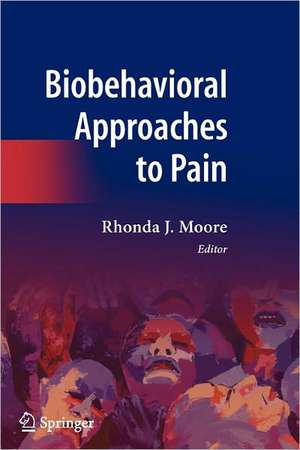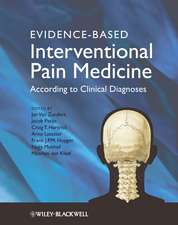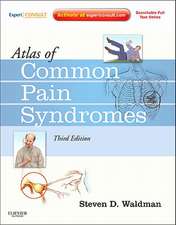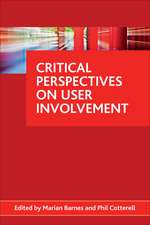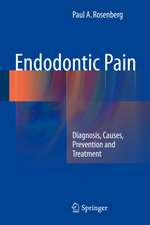Biobehavioral Approaches to Pain
Editat de Rhonda J. Moore Cuvânt înainte de J. A. Paiceen Limba Engleză Paperback – 29 oct 2010
This pathbreaking volume synthesizes a rich knowledge base from across disciplines, including neurobiologic, genetic, biobehavioral, clinical, narrative, substance abuse, health services,ethical and policy perspectives, for a deeper understanding of the impact of pain on individual lives and the larger society. Its international panel of contributors highlights special issues and review best practice guidelines, from placebo effects to cancer, Whiplash Associated Disorders to pain imaging to complementary medicine, phantom limb pain to gene therapies to AIDS. Among the topics covered:
- The distinction between acute and chronic pain: is it clinically useful?
- Improving clinical assessment of patients with pain.
- Age and sex differences in pain.
- The what, how and why of the placebo and nocebo effect
- Psychosocial and partner-assisted biopsychosocial interventions for disease-related pain
- Substance abuse issues in pain treatment.
- The personal, social and economic costs of chronic pain.
| Toate formatele și edițiile | Preț | Express |
|---|---|---|
| Paperback (1) | 663.03 lei 43-57 zile | |
| Springer – 29 oct 2010 | 663.03 lei 43-57 zile | |
| Hardback (1) | 738.20 lei 43-57 zile | |
| Springer – 2 dec 2008 | 738.20 lei 43-57 zile |
Preț: 663.03 lei
Preț vechi: 697.92 lei
-5% Nou
Puncte Express: 995
Preț estimativ în valută:
126.87€ • 132.82$ • 104.98£
126.87€ • 132.82$ • 104.98£
Carte tipărită la comandă
Livrare economică 07-21 aprilie
Preluare comenzi: 021 569.72.76
Specificații
ISBN-13: 9781441926845
ISBN-10: 1441926844
Pagini: 600
Ilustrații: XXXII, 568 p.
Dimensiuni: 155 x 235 x 32 mm
Greutate: 0.83 kg
Ediția:Softcover reprint of hardcover 1st ed. 2009
Editura: Springer
Colecția Springer
Locul publicării:New York, NY, United States
ISBN-10: 1441926844
Pagini: 600
Ilustrații: XXXII, 568 p.
Dimensiuni: 155 x 235 x 32 mm
Greutate: 0.83 kg
Ediția:Softcover reprint of hardcover 1st ed. 2009
Editura: Springer
Colecția Springer
Locul publicării:New York, NY, United States
Public țintă
Professional/practitionerCuprins
The Experience of Pain and Suffering from Acute and Chronic Pain.- The Neuroanatomy of Pain and Pain Pathways.- The Genetic Epidemiology of Pain.- Pain and the Placebo Effect.- The Narrative Approach to Pain.- Understanding and Enhancing Patient and Partner Adjustment to Disease-Related Pain: A Biopsychosocial Perspective.- Sex Differences in Pain.- Pain in Children.- Pain in the Older Person.- Healthcare Economic Evaluation of Chronic Pain: Measuring the Economic, Social and Personal Impact of Chronic Pain and its Management.- Chemotherapy Induced Peripheral Neuropathies (CIPNs): A Biobehavioral Approach.- Pain and Use of Health Services Among Persons Living with HIV.- Pain Measurement.- Phantom Pain.- Pain: Substance Abuse Issues in the Treatment of Pain.- The Use of Complementary and Alternative Medicine for Pain.- Imaging Modalities for Pain.- Pain, Transportation Issues and Whiplash.- Gene Therapy for Chronic Pain.- Palliative Care and Pain Management in the United States.- Pain in Society: Ethical Issues and Public Policy Concerns.
Recenzii
From the reviews:
"Moore … has put together a multidisciplinary and multidimensional examination of the complex phenomenon of pain that collectively is cognizant of the various molecular, neurophysical, biological, environmental, emotional, psychosocial, and societal factors that impact the human experience of pain and the treatment of pain. Aimed at scientists, policy analysts, and clinicians interested in a holistic understanding of pain, the 21 chapters she presents discuss the experience of pain and suffering from acute and chronic pain … ." (SciTech Book News, March, 2009)
"This book describes pain in all of its facets within a multidisciplinary, biobehavioral framework, addressing management, evaluation, and treatment of pain as well. … The audience is … health professionals, psychologists, and specialists in pain management or palliative care, as well as researchers and students in the field of public health. … This book is well written with helpful tables and figures. … This is a thorough look at the issue of pain from a biobehavioral approach, which includes the interactive roles of various factors." (Gary B Kaniuk, Doody’s Review Service, April, 2009)
"This book, edited by Rhonda Moore and including contributions from a multidisciplinary panel of experts in the field from many countries, follows this tradition. … The organization of the chapters reflects the reality … interaction of multiple notions and skills is required for the correct global assessment of patients with pain. The book’s 21 chapters are generally comprehensive and well referenced. … This book should be of interest to a large readership and could help to increase awareness of the specific features of chronic pain." (Didier Bouhassira, New England Journal of Medicine, Vol. 361 (2), July, 2009)
“Book is informative, as it tries to reach various disciplines that play crucial role in managing pain. … The uniqueness of thetopics concerned is giving the meaning and explaining how they interact with one another. This makes the book more interesting and deepens the understanding. … book offers wide scope for various specialties to work for the pain management and research. … the book is good read!!” (T. S. Seemanthini, Disabilities and Impairments, Vol. 26 (2), 2012)
"Moore … has put together a multidisciplinary and multidimensional examination of the complex phenomenon of pain that collectively is cognizant of the various molecular, neurophysical, biological, environmental, emotional, psychosocial, and societal factors that impact the human experience of pain and the treatment of pain. Aimed at scientists, policy analysts, and clinicians interested in a holistic understanding of pain, the 21 chapters she presents discuss the experience of pain and suffering from acute and chronic pain … ." (SciTech Book News, March, 2009)
"This book describes pain in all of its facets within a multidisciplinary, biobehavioral framework, addressing management, evaluation, and treatment of pain as well. … The audience is … health professionals, psychologists, and specialists in pain management or palliative care, as well as researchers and students in the field of public health. … This book is well written with helpful tables and figures. … This is a thorough look at the issue of pain from a biobehavioral approach, which includes the interactive roles of various factors." (Gary B Kaniuk, Doody’s Review Service, April, 2009)
"This book, edited by Rhonda Moore and including contributions from a multidisciplinary panel of experts in the field from many countries, follows this tradition. … The organization of the chapters reflects the reality … interaction of multiple notions and skills is required for the correct global assessment of patients with pain. The book’s 21 chapters are generally comprehensive and well referenced. … This book should be of interest to a large readership and could help to increase awareness of the specific features of chronic pain." (Didier Bouhassira, New England Journal of Medicine, Vol. 361 (2), July, 2009)
“Book is informative, as it tries to reach various disciplines that play crucial role in managing pain. … The uniqueness of thetopics concerned is giving the meaning and explaining how they interact with one another. This makes the book more interesting and deepens the understanding. … book offers wide scope for various specialties to work for the pain management and research. … the book is good read!!” (T. S. Seemanthini, Disabilities and Impairments, Vol. 26 (2), 2012)
Textul de pe ultima copertă
Biobehavioral Approaches in Pain
Edited by Rhonda J. Moore, National Institute of Health, Bethesda, Maryland
Pain is a common symptom, yet it is frequently underevaluated and undertreated. It is difficult to define, describe—and sometimes to prove. It’s pain, and suspicions of exaggerations often add further insult to a patients’ injuries. Biobehavioral Approaches to Pain translates this highly subjective experience—and its physical, psychological, social, and cultural dimensions—into practical insights key to transforming the field of pain management.
This pathbreaking volume synthesizes a rich knowledge base from across disciplines, including neurobiologic, genetic, biobehavioral, clinical, narrative, substance abuse, health services,ethical and policy perspectives, for a deeper understanding of the impact of pain on individual lives and the larger society. Its international panel of contributors highlights special issues and review best practice guidelines, from placebo effects to cancer, Whiplash Associated Disorders to pain imaging to complementary medicine, phantom limb pain to gene therapies to AIDS. Among the topics covered:
Edited by Rhonda J. Moore, National Institute of Health, Bethesda, Maryland
Pain is a common symptom, yet it is frequently underevaluated and undertreated. It is difficult to define, describe—and sometimes to prove. It’s pain, and suspicions of exaggerations often add further insult to a patients’ injuries. Biobehavioral Approaches to Pain translates this highly subjective experience—and its physical, psychological, social, and cultural dimensions—into practical insights key to transforming the field of pain management.
This pathbreaking volume synthesizes a rich knowledge base from across disciplines, including neurobiologic, genetic, biobehavioral, clinical, narrative, substance abuse, health services,ethical and policy perspectives, for a deeper understanding of the impact of pain on individual lives and the larger society. Its international panel of contributors highlights special issues and review best practice guidelines, from placebo effects to cancer, Whiplash Associated Disorders to pain imaging to complementary medicine, phantom limb pain to gene therapies to AIDS. Among the topics covered:
- The distinction between acute and chronic pain: is it clinically useful?
- Improving clinical assessment of patients with pain.
- Age and sex differences in pain.
- The what, how and why of the placebo and nocebo effect
- Psychosocial and partner-assisted biopsychosocial interventions for disease-related pain
- Substance abuse issues in pain treatment.
- The personal, social and economic costs of chronic pain.
Caracteristici
Foreword by Judith Paice, Northwestern University Medical School Places pain in a social context and a public health context Includes supplementary material: sn.pub/extras
